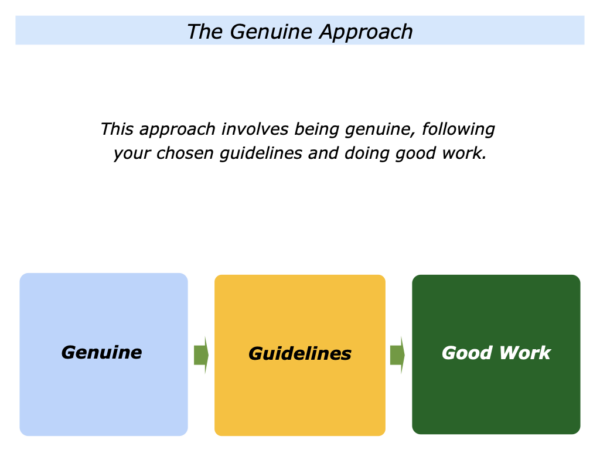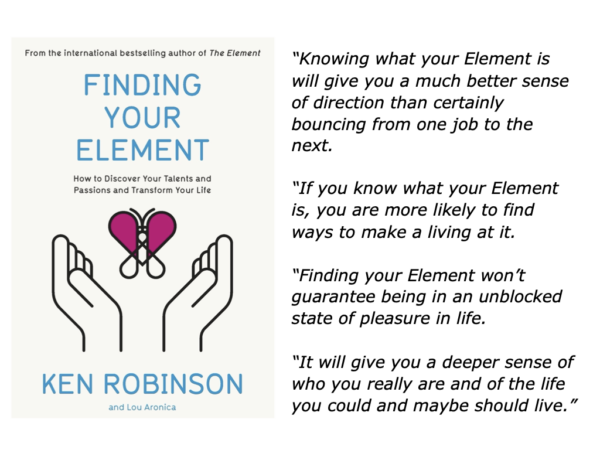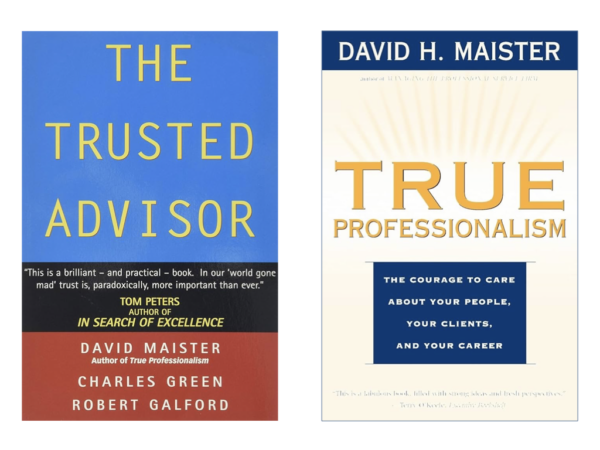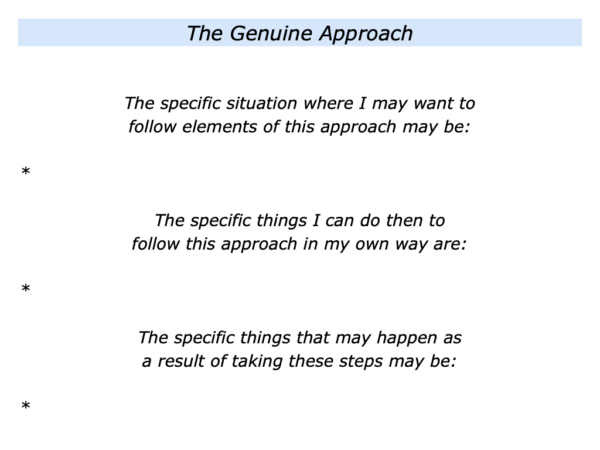
There are many ways to do fine work. One approach is to be genuine, follow your chosen guidelines and do good work. It is then to keep developing as a person and as a professional.
This approach is the opposite of what some people call the imposter syndrome. It involves people being real, doing rewarding work and getting positive results. It involves focusing on the following themes.
Genuine
Let’s start by looking at your own work. When do you feel genuine? When are you doing what you believe in? When are you building on your strengths? When are you aiming to be the best you can be?
Different people give different answers to these questions. Here are some that people mention when exploring this theme.
Genuine – I feel genuine when I am
doing the following kinds of work:
Helping a troubled person in my work as a counsellor … Caring for people in my role as a nurse … Doing interior design for houses … Singing certain kinds of songs as a performer.
Orchestrating teams to achieve a compelling goal … Solving technical problems when helping clients … Writing positive articles that may inspire people … Passing on knowledge that helps people to succeed.
Some people feel genuine when they are in their element – at ease and yet able to excel. Sir Ken Robinson’s TED talk on creativity encouraged many people to focus on this theme. Ken explained:
“Being in your Element is doing something for which you have a natural feel. It is more than doing things you are good at. You have to love it, too.”

People who follow this principle are more likely to feel alive and fulfilled, says Ken. Being in your element can bring great satisfaction. Let’s look at one person who took this approach.
Sue – Being Genuine And Using Her
Strengths To Help People To Succeed
Several years ago I worked with Sue who was a superb project manager. She loved implementing projects, working as a partner with clients and helping them to achieve success.
Sue had recently joined her present company but felt ill at ease in certain situations. She expressed this in the following way.
“Sometimes I am asked to lead sales pitches with potential clients, but this is not my strength. I am not somebody who waves their arms around and tries to sell things.
“Somebody told me to try to fake it until I make it. But I am not happy doing that, I feel like an imposter. Can we look at how to manage these sales pitches?”
We began by focusing on when Sue did her best work with her colleagues and clients. She had several qualities demonstrated by good implementors.
Sue liked to focus on a specific goal, make a plan and create a superb delivery team. She was also good at building relationships with similar people to herself – Doers – in the client organisation. She then worked alongside these people to deliver success.
Looking ahead, we explored how Sue could play to her strengths when managing sales pitches. This eventually led to her making the following plan.
She could continue to take responsibility for sales pitches. The first step would be to do lots of research ahead of the pitch regarding the client’s challenges and goals.
She could clarify the pitch team’s aims. These included being able: a) to show they understood the client’s goals; b) to show how their company could help the client to achieve their goals; c) to deliver a positive pitch that increased the chances of achieving success.
She could create a team of complementary talents that made the pitch. For example, an inspiring key speaker, such as her CEO, plus herself as an implementer who would focus on the practical steps for helping the client to succeed.
She and the team could rehearse ahead of the pitch to make sure: a) they put the client at the centre; b) they gave many examples of how they could help the client to succeed; c) they provided answers to any challenging questions.
She could contact the client two days before the pitch to double check they would be covering everything the client wanted. She could also let the client know who would be attending and their different roles during the pitch.
This approach mirrored elements of the one Sue had followed at their previous company. She explained this in the following way.
“My role on the pitch team was to do all the research, make sure we hit the brief and manage the team. The founder or sales director led the actual pitch.
“My role in the presentation was to describe the actual process and answer any detailed questions. This approach played to our strengths and often worked well with the potential clients.”
Looking ahead, we explored how Sue could set up this approach in their new company. This would require her to being able:
To show she would still take responsibility for managing the pitch process;
To show how this approach could utilise people’s strengths and increase the chances of success;
To show how she could pilot it at the next pitch and help the team to its best to deliver success.
Sue presented this approach to their CEO, who gave it their backing. The approach played to people’s strengths. It also proved successful and led to the company getting more business.
Sue liked the approach and also felt more genuine. She expressed this in the following way.
“I have always been happier as the stage manager rather than the lead person in the spotlight. I enjoy creating an environment that enables other people to shine and deliver success.”
This highlights another theme demonstrated by people who aim to be real, do rewarding work and get the desired results.
Guidelines
People who are genuine aim to follow certain guidelines in their work. They may call these their principles, values or professional standards.
People who do what they believe in often feel more at ease. They live in what the existentialists called good faith. They are true to themselves and aim to translate their beliefs into action.
Such people often gain strength from following their chosen guidelines. They keep returning to these when making decisions, doing good work or dealing with crises.
Some organisations also encourage their people to focus on certain guidelines in their daily work. David Maister highlighted this approach in books such as The Trusted Advisor, True Professionalism and Managing The Professional Firm.

David maintained that most companies have the same mission. This is: a) to provide profits for their shareholders; b) to provide great service for their customers; c) to provide a great workplace for their people.
Great service organisations mirror some of these guidelines. Different organisations may describe their purpose in different ways, but they often follow similar principles. They aim:
To use their strengths to do superb work that
helps their stakeholders to achieve success.
Let’s return to the principle of feeling genuine. What are the guidelines you believe in following in your work? How do you aim to translate these into action?
What may be the potential pluses of following these guidelines? What may be the potential minuses? How can you build on the pluses and manage the consequences of any minuses?
Great workers often aim be genuine and follow their chosen guidelines. This can then lead to the next theme.
Good Work
Many people aim do good work. Everybody has strengths. Everybody has talents in certain activities. The gifts they have been given can be used to do good work that helps people or the planet.
Many people feel humble and alive when applying their gifts. They enjoy the opportunity to use these in their daily lives and work. As the musician Marcus Miller said:
“It’s a great thing about being a musician: you don’t stop until the day you die, you can improve. So it’s a wonderful thing to do.”
Many people love to build on their strengths and do superb work. Sometimes this comes easily, sometimes they need to follow rituals to channel this flow. They love to channel this spirit, however, and get a sense of satisfaction.
Such people may also feel grateful for the gifts they have been given. They echo similar sentiments to those expressed by the author Elizabeth Gilbert in one of her TED talks.
She described how our gifts do not belong to us – they are on loan to us. We cannot take credit for our gifts, but it is up to us how we use them. Some find this to be a remarkably freeing approach. Here are some of the relevant passages from her talk.
In ancient Greece and ancient Rome people did not happen to believe that creativity came from human beings back then.
People believed that creativity was this divine attendant spirit that came to human beings from some distant and unknowable source for distant and unknowable reasons.
The Greeks famously called these divine attendant spirits of creativity ‘Daemons’. Socrates famously believed that he had a Daemon who spoke to him from afar.
The Romans had the same idea but they called that sort of disembodied spirit a ‘Genius’ … which was great because the Romans did not actually think that a genius was a particularly clever individual.
They believed that a genius was this sort of magical divine entity who was believed to literally live in the walls of an artist’s studio … and who would come out and invisibly assist the artist with their work and who would shape the outcome of that work.
Maybe artistry doesn’t have to be quite so full of anguish if you never happened to believe, in the first place, that the most extraordinary aspects of your being came from you.
But maybe if you just believed that they were on loan to you from some unimaginable source for some exquisite portion of your life to be passed along when you’re finished. (This) starts to change everything.
There are many ways to build on your strengths. One approach is to be genuine and follow your chosen guidelines. It is then to do good work that helps people or the planet.
Let’s return to your own life and work. Looking ahead, can you think of a situation where you may want to follow elements of the genuine approach? How can you do this in your own way?
If you wish, try tackling the exercise on this theme. This invites you to complete the following sentences.



Leave a Reply